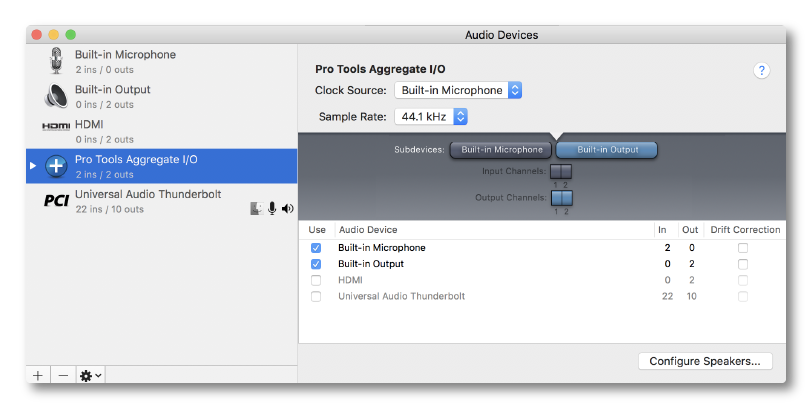Aggregate Audio Device Mac Ableton
Getting started. In this guide, we will show you how to manage multiple audio devices as a single aggregate device on Windows and macOS. Whether you have a Mac or PC, you’ll learn how to combine multiple audio devices into one audio device identity. How Can I Create an Aggregate Device (OS X)? An Aggregate Device is a virtual audio interface within your computer system which utilizes the inputs and outputs of one or more physical audio interfaces connected to your computer.
I am trying to create an aggregate audio device with my MOTU Ultralite, Roland Aira devices (TB-3, TR-8 and System 1m), and my Pioneer DJM2000 nexus. The reason I want to use an aggregate device is so that I can give the Aira devices, and in particular each drum sound coming from the TR-8, its own channel in Live 9.The master in the chain is the MOTU Ultralite, followed by the DJM2000, the TB-3, TR-8 and System 1m.

The MOTU Ultralite works fine, and I have no problems with it, but when I add each of the Aira devices, the quality of the sound is unbelievably bad, and unusable (although they work fine if I plug the audio outputs into the Ultralite, but then I don’t have the sound-per-channel control that I want to use).
Could it be a problem with too much information going over USB? I have 2x USB3.0 hubs running into an OWC Thunderbolt 2 dock, so I would have thought that the bandwidth of this dock would be easily able to handle these devices, as the only other things plugged in are 2x USB3.o external hard drives and then a series of USB midi controllers.
Please watch the video below for an example of the problem, and please please please let me know if any of you have experienced similar problems, and how you solved them.
Thanks in advance.
https://www.youtube.com/watch?v=lw5jt5IWDsI
Anyone who has been making music with Macs for more than a decade will remember the “bad old days” of OS9, when audio and MIDI streaming in and out of a computer meant relying on specially written drivers and the OMS MIDI system. These were bolt-ons, and together with OS9’s inherent stability problems related to Extensions (I still shudder when I think of how often Macs used to crash compared to today), meant you were more or less at the mercy of whoever had written the drivers for your device.
This all changed with OS X, which uses CoreAudio and CoreMIDI frameworks built in at system level. Developers are able to use these standards when making hardware and software, and the result is an infinitely more reliable way to transfer data. Some time ago, OS X gained a rather interesting ability which addressed a fairly common problem for musicians. This is the ability to aggregate multiple audio interfaces or hardware connections into a single virtual device. So if you have two audio interfaces, one with two inputs and one with four, you can connect them both, perform a quick setup and they will appear to your DAW as a six input device. It scales up too, so you can add as many devices as you can physically connect. Since DAWs can normally only see one interface at a time, aggregating several devices “fools” them into seeing several devices at the same time. Here’s how it works.
These include loading VST and AU plug-ins, as well as the ability to browse and preview sounds from the Push browser. We therefore remain committed to continuing support for the original Push and will be adding improvements wherever possible in the future.The free update to Live 9.5 brings improvements and frequently-requested features to the original Push. You’ve probably seen that we have just released a new, redesigned Push. Ableton live 9.5 x32 mac torrent. As much work as we’ve put into this new version of our hardware instrument, we also realize that many of you have invested just as much time and effort learning to play and use your original Push.
Step 1
Open the Audio MIDI Setup application on your Mac and go to the Audio Devices window. Click on the plus icon at the bottom left of the window to create a new Aggregate Device, then double click in its name field and assign it a name.
Step 2
In this example you’ll see that I have two external devices connected as well as my MacBook Pro’s built-in audio hardware and a Soundflower virtual routing device. For simplicity’s sake, what I will do is assign the two hardware interfaces to work as one. So I click the Use boxes for the Xiosynth and the Yamaha device.
Step 3
You’ll notice that my Aggregate device is now reporting 14 ins and outs, which is the sum of the 2/2 of the Xiosynth and the 12/12 of the Yamaha. I have set the larger Yamaha device as my Clock source, and gone into the Xiosynth’s tab to make sure that it is working at the same sample rate as the Yamaha.
Step 4
Next I open the audio preferences in my DAW, which here happens to be Logic, and set the input and output to the Aggregate device.
Step 5
Now when I create an audio track, I can set its input and output to use any of the 14 channels available, either when creating the track or from the channel inspector. These correspond to the twelve channels on the Yamaha plus the two on the Xiosynth.
No Audio Ableton
Step 6
Ableton Audio Driver
Here is the same thing set up in Reason and you will notice again that there are 14 ins and outs available. If you needed even more you could add more devices or even use the built-in audio hardware on your Mac, though it won’t offer the same recording quality as a dedicted unit.